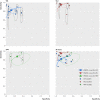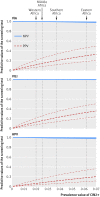Performance of alternative strategies for primary cervical cancer screening in sub-Saharan Africa: systematic review and meta-analysis of diagnostic test accuracy studies
- PMID: 26142020
- PMCID: PMC4490835
- DOI: 10.1136/bmj.h3084
Performance of alternative strategies for primary cervical cancer screening in sub-Saharan Africa: systematic review and meta-analysis of diagnostic test accuracy studies
Abstract
Objective: To assess and compare the accuracy of visual inspection with acetic acid (VIA), visual inspection with Lugol's iodine (VILI), and human papillomavirus (HPV) testing as alternative standalone methods for primary cervical cancer screening in sub-Saharan Africa.
Design: Systematic review and meta-analysis of diagnostic test accuracy studies.
Data sources: Systematic searches of multiple databases including Medline, Embase, and Scopus for studies published between January 1994 and June 2014.
Review methods: Inclusion criteria for studies were: alternative methods to cytology used as a standalone test for primary screening; study population not at particular risk of cervical cancer (excluding studies focusing on HIV positive women or women with gynaecological symptoms); women screened by nurses; reference test (colposcopy and directed biopsies) performed at least in women with positive screening results. Two reviewers independently screened studies for eligibility and extracted data for inclusion, and evaluated study quality using the quality assessment of diagnostic accuracy studies 2 (QUADAS-2) checklist. Primary outcomes were absolute accuracy measures (sensitivity and specificity) of screening tests to detect cervical intraepithelial neoplasia grade 2 or worse (CIN2+).
Results: 15 studies of moderate quality were included (n=61,381 for VIA, n=46,435 for VILI, n=11,322 for HPV testing). Prevalence of CIN2+ did not vary by screening test and ranged from 2.3% (95% confidence interval 1.5% to 3.3%) in VILI studies to 4.9% (2.7% to 7.8%) in HPV testing studies. Positivity rates of VILI, VIA, and HPV testing were 16.5% (9.8% to 24.7%), 16.8% (11.0% to 23.6%), and 25.8% (17.4% to 35.3%), respectively. Pooled sensitivity was higher for VILI (95.1%; 90.1% to 97.7%) than VIA (82.4%; 76.3% to 87.3%) in studies where the reference test was performed in all women (P<0.001). Pooled specificity of VILI and VIA were similar (87.2% (78.1% to 92.8%) v 87.4% (77.1% to 93.4%); P=0.85). Pooled sensitivity and specificity were similar for HPV testing versus VIA (both P ≥ 0.23) and versus VILI (both P ≥ 0.16). Accuracy of VIA and VILI increased with sample size and time period.
Conclusions: For primary screening of cervical cancer in sub-Saharan Africa, VILI is a simple and affordable alternative to cytology that demonstrates higher sensitivity than VIA. Implementation studies are needed to assess the effect of these screening strategies on the incidence and outcomes of cervical cancer in the region.
© Fokom-Domgue et al 2015.
Conflict of interest statement
Competing interests: All authors have completed the ICMJE uniform disclosure form at
Figures




References
-
- Castellsague X, de Sanjose S, Aguado K, et al. HPV and cervical cancer in the 2007 report. Vaccine 2007;25 suppl 3:C1-230. - PubMed
-
- Arbyn M, Castellsague X, de Sanjose S, et al. Worldwide burden of cervical cancer in 2008. Ann Oncol 2011;22:2675-86. - PubMed
-
- Blumenthal P, Gaffikin L, Deganus S, Lewis R, Emerson M, Adadevoh S. Cervical cancer prevention:safety, acceptability, and feasibility of a single-visit approach in Accra, Ghana. Am J Obstet Gynecol 2007;196:407 e1-8; discussion 407 e8-9. - PubMed
-
- Katz I, Wright A. Preventing cervical cancer in the developing world. N Engl J Med 2006;354:1110. - PubMed
-
- Goldie S, Kuhn L, Denny L, Pollack A, Wright T. Policy analysis of cervical cancer screening strategies in low-resource settings: clinical benefits and cost-effectiveness. JAMA 2001;285:3107-15. - PubMed
Publication types
MeSH terms
Substances
LinkOut - more resources
Full Text Sources
Other Literature Sources
Medical
